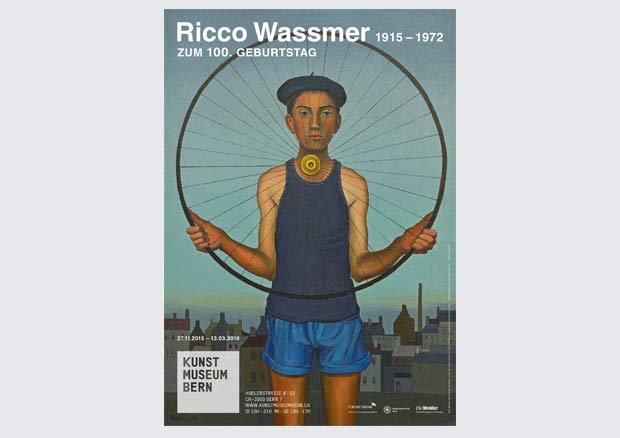Ricco Wassmer 1915-1972. His Centenary Birthday, 27.11.2015 – 13.03.2016
Ricco Wassmer 1915-1972. His Centenary Birthday
From Nov. 27, 2015 until March 13, 2016 the Kunstmuseum Bern is mounting the exhibition Ricco Wassmer 1915-1972: His Centenary Birthday. With strikingly surreal arrangements, the Bernese artist Ricco Wassmer produced a unique oeuvre that can be classified somewhere between naive painting, new objectivity, and magic realism. The key themes in the artist’s oeuvre are loss of the carefree paradise of childhood, slender youths, sailors, sailing ships, still-lifes, and a yearning for far-off places.
On the occasion of Ricco Wassmer’s 100th birthday (his real was name Erich Hans Wassmer, 1915–1972), the Kunstmuseum Bern is presenting a comprehensive retrospective of the work of this Swiss painter and photographer in an exhibition lasting from November 27, 2015, until March 13, 2016. With over 200 loans originating largely from private collectors, the show will be providing a broad overview of Ricco Wassmer's work. Many of the artworks have never before been shown in public—and the show includes newly discovered pieces too. The exhibition is focusing especially on the reciprocity of painting and photography, because the artist not only began using the camera as a substitute for drawing from live models, but the medium also acquired increasing significance from the 1950s onward. The show follows a chronological order and is based on the catalogue raisonné of the artist’s paintings and objects (Catalogue raisonné der Gemälde und Objekte). Betty Stocker began the research for the catalogue and Marc-Joachim Wasmer took over from 2008. The richly illustrated catalogue raisonné with a biography and a critical list of works has been published in conjunction with the exhibition in Bern.
Close ties with the
Bern art scene linked to Kunsthalle director Arnold Rüdlinger
Wassmer was the son
of an industrialist and spent his youth in the artistic milieu of Bremgarten
castle. After studying in Munich and Paris, he returned to Switzerland in 1939.
In 1948/49 he spent several months in Tahiti and then sailed as an assistant
cook on a freighter around the world twice. From 1950, he lived part of the
time in the heart of France near Vichy, but his bonds to the art scene in Bern
in connection with Kunsthalle director Arnold Rüdlinger remained close. In 1963
he moved to Ropraz near Lausanne, and in 1972 he died aged 56 from the
aftereffects of a pulmonary disorder.
Nostalgia and
melancholy
Ricco Wassmer’s
artistic career is closely linked to the “heroic years” of Bernese art, but
even from the very beginning he stood out as an artist who explored new
frontiers and as a rebel who found a voice in enigmatic paintings. Wassmer was
a profoundly melancholy person who pursued an autonomous artistic path, off the
beaten track of abstraction and the avant-garde. His pictures were his means of
asserting himself and of expressing his homoerotic inclinations. Driven by his
yearning for youth as the embodiment of the ideal world he experienced during
his childhood, he painted encrypted still-lifes and scenes using cliché images
of adolescence as well as objects, numbers, texts, and references from the
visual arts.
Image structures
based on fantasy and reality, dream and memories
Ephebus is the core
topic of his work, and already in ancient Greece a cult was devoted to its
worship. It signifies the turning point between male adolescence and maturity in
the phase of emerging sexuality. In contrast to Otto Meyer-Amden before him,
who illustrated the individual as merging ether-like with society and ritual,
Ricco Wassmer depicted slender adolescents in the style of the old masters as
if they were idols you could take hold of. From the 1950s onward, he worked almost
exclusively after own photographs or those of others in a polished style, derived
from the study of the works of Niklaus Stoecklin and Ingres as well as Max
Ernst, Paul Delvaux, Man Ray, and Balthus. In his paintings fantasy and
reality, dream and memories conflate into pictorial structures. In pursuing
such an approach, Ricco Wassmer created his unmistakable visual vocabulary, corresponding
with Harald Szeemann’s notion of “individual mythology.”
Contact Person: Michèle Thüring, , T +41 31 328 09 19
Images: Marie Louise Suter, , T +41 31 328 09 53


